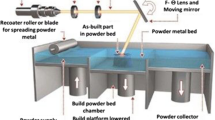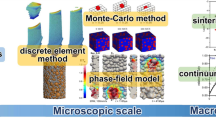Abstract
A mathematical model is developed to characterize the progressive time-evolution of a fragmenting incandescent object. The objective of these models is to provide a spatio-thermal footprint of the fragmentation field, which can be useful to guide fire safety rules in manufacturing workplaces, as well as to estimate fire hazards. Ascertaining the time-evolution of the temperature of the fragments is quite difficult to measure experimentally, which motivates the model development. Initially, analytical models based solely on ballistics, which provide qualitative trends, are developed to provide insight into the fundamental ratios that govern safe operating conditions. Thereafter, rapid numerical spatio-thermal models, which provide quantitative information, are then developed, based on particle methods. The model uses the released energy from the initial blast pulse to provide the starting kinetic energy of the system of particles and then numerically computes the trajectory and thermal state of the fragments under the influence of
-
drag from the surrounding air,
-
gravitational settling and
-
convective and radiative cooling.
Numerical examples and provided and extensions to high-fidelity are discussed.





Similar content being viewed by others
Notes
We will discuss this assumption later in the paper.
The viscosity coefficient for air is \(\mu _f=0.000018\) Pa/s.
One conclusion from these experiments is that aerosols generated from a blast containing toxic materials cannot be assumed to be inactivated by the blast itself, which is consistent with findings of Eshkol and Katz [37] and Kanemitsu [38], where Hepatitis B from a suicide bomber was transmitted to survivors of the blast.
References
Wingerden VK, Hesby I, Eckhoff R (2011) Ignition of dust layers by mechanical sparks. In: Proceedings of 7th global congress on process safety, Chicago, Ill
Fernandez-Pello AC (2017) Wildland fire spot ignition by sparks and firebrands. Fire Saf J 91:2–10
National Interagency Fire Center. www.nifc.gov/fireInfo/nfn.htm
Prestemon JP, Hawbaker TJ, Bowden M, Carpenter J, Brooks MT, Abt KL, Sutphen R, Scranton S (2013) Wildfire ignitions: a review of the science and recommendations for empirical modeling (technical report). US Department of Agriculture: Forest Service, Asheville
Ahrens M (2013) Brush, grass and forest fires (technical report). National Fire Protection Association, Quincy
Ramljak I, Majstrovic M, Sutloviec S (2014) Statistical analysis of particles of conductor clashing. Dubrovnic May 13–16
National Fire Protection Association (2014) NFPA 51B: standard for fire prevention during welding, cutting and other hot work
US Fire Administration. http://www.usfa.fema.gov/statistics/estimates/wildfire.shtm
Pleasance GE, Hart JA (1977) An examination of particles from conductors clashing as possible source of bushfire ignition. State Electricity Commission of Victoria (SEC), Victoria, Australia, Research and Development Department, Report FM-1
Stokes AD (1990) Fire ignition by copper particles of controlled size. J Electr Electron Eng Aust 10:188–194
Rowntree G, Stokes A (1994) Fire ignition of aluminum particles of controlled size. J Electr Electron Eng 117–123
Hadden R, Scott S, Lautenberger C, Fernandez-Pello CA (2011) Ignition of combustible fuel beds by hot particles: an experimental and theoretical study. Fire Technol 47:341–355
Urban JL, Zak CD, Song J, Fernandez-Pello AC (2017) Smolder spot ignition of natural fuels by a hot metal particle. Proc Combust Inst 36(2):3211–3218. ISSN 1540-7489. https://doi.org/10.1016/j.proci.2016.09.014
Baum HR, McCaffrey BJ (1989) Fire induced flow field-theory and experiments fire safety science. In: Wakamatsu et al. (eds) Proceedings of the second international symposium. Washington DC, pp 129–148
Tarifa CS, del Notario PP, Moreno FG (1965) On the flight paths and lifetimes of burning particles of wood. Proc Combust Inst 10:1021–1037
Tarifa CS, Del Notario PP, Moreno FG, Villa AR (1967) Transport and combustion of firebrands. U.S. Department of Agriculture Forest Service (Final Report of Grants GF-SP-114 and GF-SP-146. Madrid, May)
Sardoy N, Consalvi JL, Poterie B, Loraud JC, Fernandez-Pello CA (2007) Modeling transport and combustion of firebrands from burning trees. Combust Flame 150:151–169
Lee SL, Hellman JM (1970) Firebrand trajectory study using an empirical velocitydependent burning law. Combust Flame 15:265–274
Koo E, Pagni P, Linn R (2007) Using FIRETEC to describe firebrand behavior in wildfires, fire mater. 2007 San Francisco, CA
Tse SD, Fernandez-Pello AC (2006) On the flight paths of metal particles and embers generated by powerlines in high winds—a potential source of wildland fires. Fire Saf J 333–356
Mills FA, Hang X (1984) Trajectories of sparks from arcing aluminum power cables. Fire Technol 20:5–14
Rallis CJ, Mangaya BM (2002) Ignition of veld grass by hot aluminum particles ejected from clashing overhead transmission lines. Fire Technol 38:81–92
Russell BD, Benner CI, Wischkaemper JA (2012) Distribution feeder caused wildfires: mechanisms and prevention. Prot Relay Eng 43
Blackburn T (1985) Conductor clashing characteristics of overhead lines. In: Proceedings of electrical energy conferences. p 202
Pagni PJ (1993) Causes of the 20 October 1991 Oakland-hills conflagration. Fire Saf J 21:331–339
Gilbert M California Department of Forestry and Fire Protection Investigation Report: Incident number 07- CA-MVU-10432. http://www.fire.ca.gov/fire
Maranghides A, Mell W (2009) A Case Study of a Community Affected by the Witch and Guejito Fires, NIST Technical Note 1635. http://fire.nist.gov/bfrlpubs/fire09/art028.html
Badger S (2012) Large-loss fires in the United States 2011. National Fire Protection Association, Quincy
Chow CY (1980) An introduction to computational fluid dynamics. Wiley, New York
Schlichtling H (1979) Boundary-layer theory, 7th edn. McGraw-Hill, New York
Whitaker S (1972) Forced convection heat transfer correlations for flow in pipes, past flat plates, single cylinders, single spheres, and flow in packed beds and tube bundles. AIChE J 18:361–371
Hoover WG, Hoover CG (2009) Tensor temperature and shock-wave stability in a strong two-dimensional shock wave. Phys Rev E Stat Nonlinear Soft Matter Phys 80:011128/1–011128/6
Gregoire Y, Sturtzer M-O, Khasainov BA, Veyssiere B (2009) Investigation of the behavior of solid particles dispersed by high explosive. In: Int annu conf ICT 40th, 35/1–35/12
Kudryashova OB, Vorozhtsov BI, Muravlev EV, Akhmadeev IR, Pavlenko AA, Titov SS (2011) Physicomathematical modeling of explosive dispersion of liquid and powders, propellants, explos. Pyrotechnology 36:524–530
Cabalo J, Schmidt J, Wendt JOL, Scheeline A (2002) Spectrometric system for characterizing drop and powder trajectories and chemistry in reactive flows. Appl Spectrosc 56:1346–1353
Cabalo JB, Kesavan J, Sickenberger DW, Diviacchi G, Maldonado-Figueroa C, McGrady D, Stafford K (2016) Assessing the biological threat posed by suicide bombers. Report ECBC-TR-1363
Eshkol Z, Katz K (2005) Injuries from biologic material of suicide bombers. Injury 36:271–274
Kanemitsu K (2005) Does incineration turn infectious waste aseptic? J Hosp Infect 60(4):304–306
Onate E, Idelsohn SR, Celigueta MA, Rossi R (2008) Advances in the particle finite element method for the analysis of fluid-multibody interaction and bed erosion in free surface flows. Comput Methods Appl Mech Eng 197(19–20):1777–1800
Onate E, Celigueta MA, Idelsohn SR, Salazar F, Surez B (2011) Possibilities of the particle finite element method for fluid-soil-structure interaction problems. Comput Mech 48:307–318
Avci B, Wriggers P (2012) A DEM-FEM coupling approach for the direct numerical simulation of 3D particulate flows. J Appl Mech 79:010901-1–7
Leonardi A, Wittel FK, Mendoza M, Herrmann HJ (2014) Coupled DEM-LBM method for the free-surface simulation of heterogeneous suspensions. Comput Particle Mech 1(1):3–13
Bolintineanu DS, Grest GS, Lechman JB, Pierce F, SJ Plimpton, PR Schunk (2014) Particle dynamics modeling methods for colloid suspensions. Comput Particle Mech 1(3):321–356
Onate E, Celigueta MA, Latorre S, Casas G, Rossi R, Rojek J (2014) Lagrangian analysis of multiscale particulate flows with the particle finite element method. Comput Particle Mech 1(1):85–102
Zohdi TI (2004) A computational framework for agglomeration in thermo-chemically reacting granular flows. Proc R Soc 460(2052):3421–3445
Zohdi TI (2007) Computation of strongly coupled multifield interaction in particle-fluid systems. Comput Methods Appl Mech Eng 196:3927–3950
Zohdi TI (2010) On the dynamics of charged electromagnetic particulate jets. Arch Comput Methods Eng 17(2):109–135
Zohdi TI (2013) Numerical simulation of charged particulate cluster-droplet impact on electrified surfaces. J Comput Phys 233:509–526
Zohdi TI (2014) Additive particle deposition and selective laser processing—a computational manufacturing framework. Comput Mech 54:171–191
Zohdi TI (2014) Mechanically-driven accumulation of microscale material at coupled solid-fluid interfaces in biological channels. Proc R Soc Interface 11:20130922
Zohdi TI (2016) A note on firework blasts and qualitative parameter dependency. Proc R Soc. https://doi.org/10.1098/rspa.2015.0720
Zohdi TI (2003) Genetic design of solids possessing a random-particulate microstructure. Philos Trans R Soc Math Phys Eng Sci 361(1806):1021–1043
Zohdi TI (2003) On the compaction of cohesive hyperelastic granules at finite strains. Proc R Soc 454(2034):1395–1401
Zohdi TI, Cabalo J (2017) On the thermomechanics and footprint of fragmenting blasts. Int J Eng Sci 118:28–39
Author information
Authors and Affiliations
Corresponding author
Additional information
Publisher's Note
Springer Nature remains neutral with regard to jurisdictional claims in published maps and institutional affiliations.
Rights and permissions
About this article
Cite this article
Zohdi, T.I. Modeling the spatio-thermal fire hazard distribution of incandescent material ejecta in manufacturing. Comput Mech 63, 701–711 (2019). https://doi.org/10.1007/s00466-018-1617-2
Received:
Accepted:
Published:
Issue Date:
DOI: https://doi.org/10.1007/s00466-018-1617-2




